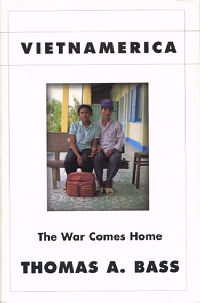
Vietnamerica:
The War Comes Home
by Thomas A. Bass
Soho Press, 1996
Reviewed by Barbara Free
The author spent several years traveling to Vietnam, The Phillippines, and upstate New York, meeting with everyone from State Department Officials and Vietnamese government officials to the people who operate refugee resettlement centers, and young Amerasians themselves. Some of these Amerasians are, in fact, second generation —their mothers were Eurasians, with French or English fathers. Some finally made it to the United States, with family or in some cases with “fake family,” persons who were not genetic relatives but passed as such to get here. Some did find their fathers, although more did not. A few had wonderful reunions with fathers who had spent years looking for them, while others were not welcomed. The U.S. military did not cooperate in helping them get here, in helping them locate their fathers, or in finding out their fathers’ full names, even when the records were there, citing the men’s right to privacy and that providing any information was an intrusion, even if the father wanted it. This is not a new policy. It has been happening since at least World War II, all over the world. The existence of children fathered by American military or civilian personnel has been happening since at least 1853, when Commodore Matthew Perry and his men arrived in the Phillippines. The Phillippino census of 1920 counted eighteen thousand Amerasians in Manila alone, according to this book. Author Pearl Buck originally coined the term “Amerasians” and started a foundation in 1967 to aid what she called “a new group of human beings.” One of the greatest problems is that, in many Asian cultures, including Vietnam, genetic purity is of extreme importance to families, in education, jobs, relationships, and just about every aspect of life. When the French were there, the wealthier class sometimes benefitted from intermarriage and their offspring were educated in French and considered French citizens. When Saigon fell, in 1975, many of those people had either already emigrated to France or went at that time. The same was true, to lesser degrees, of Laos and Cambodia. However, those children fathered by Americans were not considered American citizens, because they were not born in the United States, and the Vietnamese culture and government did not want these reminders of the American presence. Mothers were afraid the Communist government would kill them and/or their half-American children. They were not allowed to go to school or get real jobs, for the most part. Although some were airlifted out in 1975, many more were not, and many are still there, over thirty years later.
The book details efforts to help these people get to the United States, and obstacles to that maintained by various agencies, individuals, and governments. It also has a great deal of information about what was once considered to be the most successful resettlement center for Amerasians and refugees, in Utica, New York. As it turns out, there was corruption and deceit there, too. Although very little of any of these matters is known, or perhaps just isn’t considered important by most Americans, all of it fits with what this writer knew in working with some refugee families some years ago, and with experiences of Amerasians (including American women married to Japanese men and living in Japan) told to me. Sometimes we think of biracial, particularly Asian-Anglo, persons as really beautiful, but we do not always think of the problems they face, even in this country, let alone in most Asian countries. It is difficult enough to be a single parent anywhere, and more difficult in a country where poverty is endemic, but most of us cannot even imagine what life is like for these mothers and their children.
The extent of what the author calls the “Vietnamese diaspora” is another fact of which few of us are really aware. He says it includes 800,000 Vietnamese in the U.S., 200,000 in France, slightly fewer in Canada, 100,000 in Australia and Thailand, and smaller numbers in 80 other countries. This does not include ethnic Chinese from Vietnam. The biggest surprise is that 100,000 Vietnamese were sent to the former Soviet Union to work off Vietnam’s hard currency debt. We wonder where those people are now, and where their own children are. How are they treated in Russia, or Ukraine, or Siberia, or elsewhere? Some of these children were, in fact, adopted by Americans, and some agencies even specialized in that for a time. We might assume, as the official line does, that there are no more Amerasians in Asia, that they all got here, or are deceased, or leading good lives in Asia by choice. That is not the case. The former director of the center in Utica was later hired by an adoption agency to open an office in Vietnam. The book does not say where she is now.
As we stated at the beginning, this book is not well-known, not fashionable right now. It is not overtly an adoption story, but it is all about the losses of children and parents involved in war, poverty, rejection, fear, and abandonment, the same as any story of relinquishment, search, and possible eventual reunion. It isn’t just about the American fathers, it isn’t just about the Asian mothers, it isn’t just about their Amerasian offspring. It’s about all of that, and the consequences of war, colonialism, and migration that has been taking place for many thousands of years. All of our own DNA tests would show that there is really no “pure” ethnic group. But the consequences for these particular people, with whom the book is concerned, have been especially harsh.
Excerpted from the July 2008 edition of the Operation Identity Newsletter
© 2008 Operation Identity